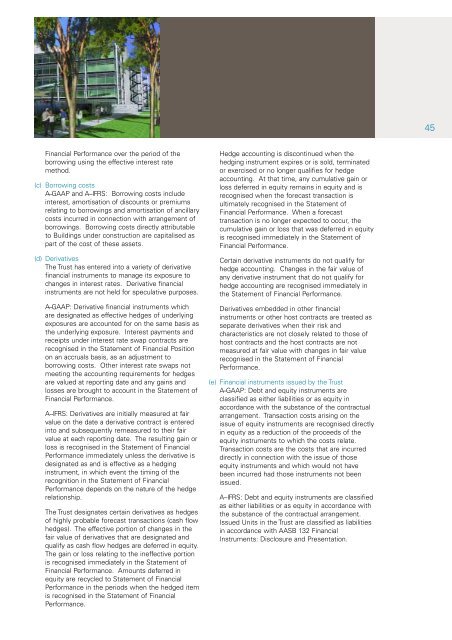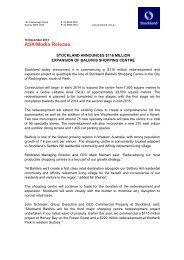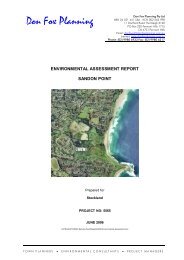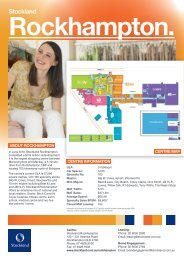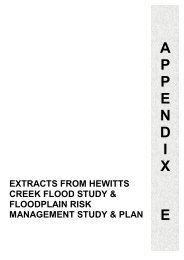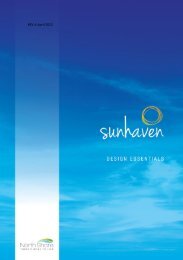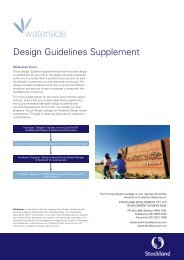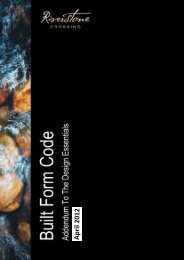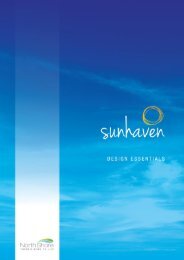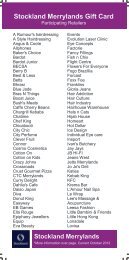SDOT2 Product Disclosure Statement - Stockland
SDOT2 Product Disclosure Statement - Stockland
SDOT2 Product Disclosure Statement - Stockland
Create successful ePaper yourself
Turn your PDF publications into a flip-book with our unique Google optimized e-Paper software.
45<br />
Financial Performance over the period of the<br />
borrowing using the effective interest rate<br />
method.<br />
(c) Borrowing costs<br />
A-GAAP and A-IFRS: Borrowing costs include<br />
interest, amortisation of discounts or premiums<br />
relating to borrowings and amortisation of ancillary<br />
costs incurred in connection with arrangement of<br />
borrowings. Borrowing costs directly attributable<br />
to Buildings under construction are capitalised as<br />
part of the cost of these assets.<br />
(d) Derivatives<br />
The Trust has entered into a variety of derivative<br />
financial instruments to manage its exposure to<br />
changes in interest rates. Derivative financial<br />
instruments are not held for speculative purposes.<br />
A-GAAP: Derivative financial instruments which<br />
are designated as effective hedges of underlying<br />
exposures are accounted for on the same basis as<br />
the underlying exposure. Interest payments and<br />
receipts under interest rate swap contracts are<br />
recognised in the <strong>Statement</strong> of Financial Position<br />
on an accruals basis, as an adjustment to<br />
borrowing costs. Other interest rate swaps not<br />
meeting the accounting requirements for hedges<br />
are valued at reporting date and any gains and<br />
losses are brought to account in the <strong>Statement</strong> of<br />
Financial Performance.<br />
A-IFRS: Derivatives are initially measured at fair<br />
value on the date a derivative contract is entered<br />
into and subsequently remeasured to their fair<br />
value at each reporting date. The resulting gain or<br />
loss is recognised in the <strong>Statement</strong> of Financial<br />
Performance immediately unless the derivative is<br />
designated as and is effective as a hedging<br />
instrument, in which event the timing of the<br />
recognition in the <strong>Statement</strong> of Financial<br />
Performance depends on the nature of the hedge<br />
relationship.<br />
The Trust designates certain derivatives as hedges<br />
of highly probable forecast transactions (cash flow<br />
hedges). The effective portion of changes in the<br />
fair value of derivatives that are designated and<br />
qualify as cash flow hedges are deferred in equity.<br />
The gain or loss relating to the ineffective portion<br />
is recognised immediately in the <strong>Statement</strong> of<br />
Financial Performance. Amounts deferred in<br />
equity are recycled to <strong>Statement</strong> of Financial<br />
Performance in the periods when the hedged item<br />
is recognised in the <strong>Statement</strong> of Financial<br />
Performance.<br />
Hedge accounting is discontinued when the<br />
hedging instrument expires or is sold, terminated<br />
or exercised or no longer qualifies for hedge<br />
accounting. At that time, any cumulative gain or<br />
loss deferred in equity remains in equity and is<br />
recognised when the forecast transaction is<br />
ultimately recognised in the <strong>Statement</strong> of<br />
Financial Performance. When a forecast<br />
transaction is no longer expected to occur, the<br />
cumulative gain or loss that was deferred in equity<br />
is recognised immediately in the <strong>Statement</strong> of<br />
Financial Performance.<br />
Certain derivative instruments do not qualify for<br />
hedge accounting. Changes in the fair value of<br />
any derivative instrument that do not qualify for<br />
hedge accounting are recognised immediately in<br />
the <strong>Statement</strong> of Financial Performance.<br />
Derivatives embedded in other financial<br />
instruments or other host contracts are treated as<br />
separate derivatives when their risk and<br />
characteristics are not closely related to those of<br />
host contracts and the host contracts are not<br />
measured at fair value with changes in fair value<br />
recognised in the <strong>Statement</strong> of Financial<br />
Performance.<br />
(e) Financial instruments issued by the Trust<br />
A-GAAP: Debt and equity instruments are<br />
classified as either liabilities or as equity in<br />
accordance with the substance of the contractual<br />
arrangement. Transaction costs arising on the<br />
issue of equity instruments are recognised directly<br />
in equity as a reduction of the proceeds of the<br />
equity instruments to which the costs relate.<br />
Transaction costs are the costs that are incurred<br />
directly in connection with the issue of those<br />
equity instruments and which would not have<br />
been incurred had those instruments not been<br />
issued.<br />
A-IFRS: Debt and equity instruments are classified<br />
as either liabilities or as equity in accordance with<br />
the substance of the contractual arrangement.<br />
Issued Units in the Trust are classified as liabilities<br />
in accordance with AASB 132 Financial<br />
Instruments: <strong>Disclosure</strong> and Presentation.


